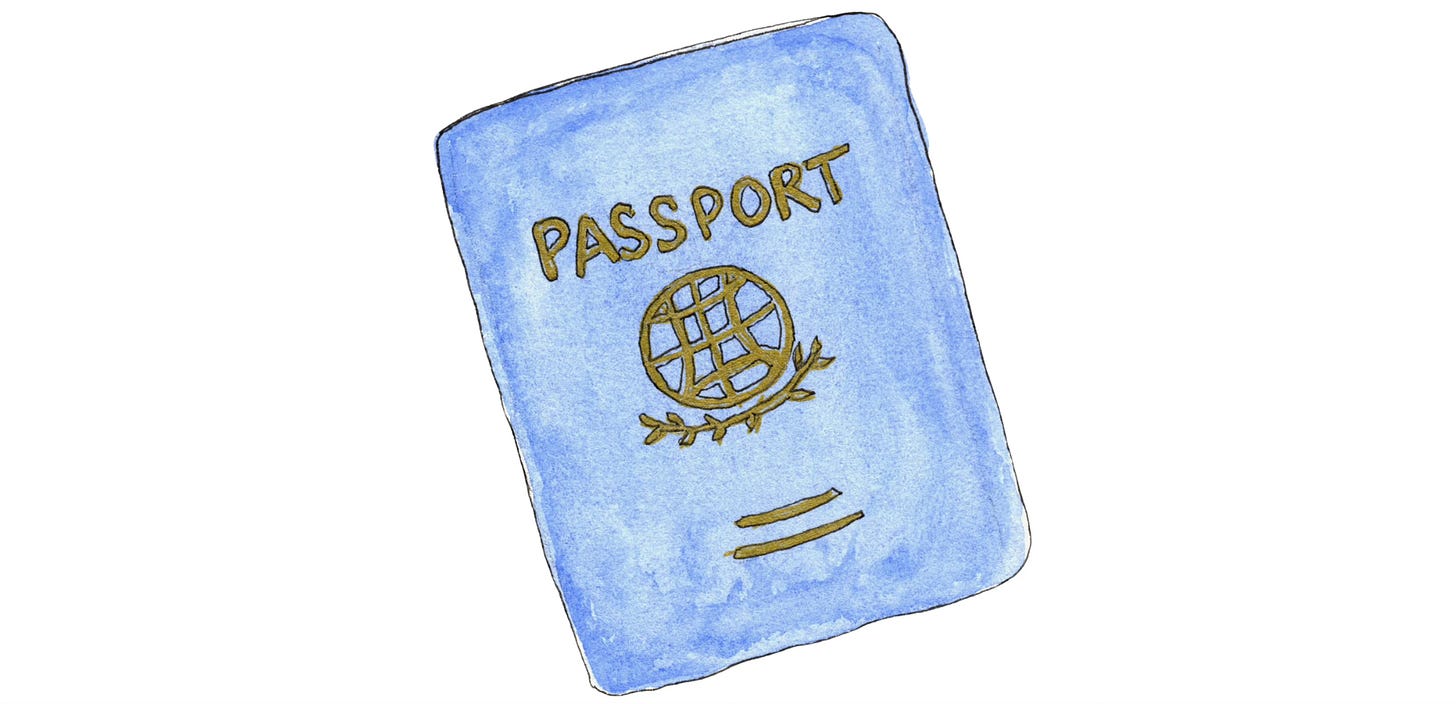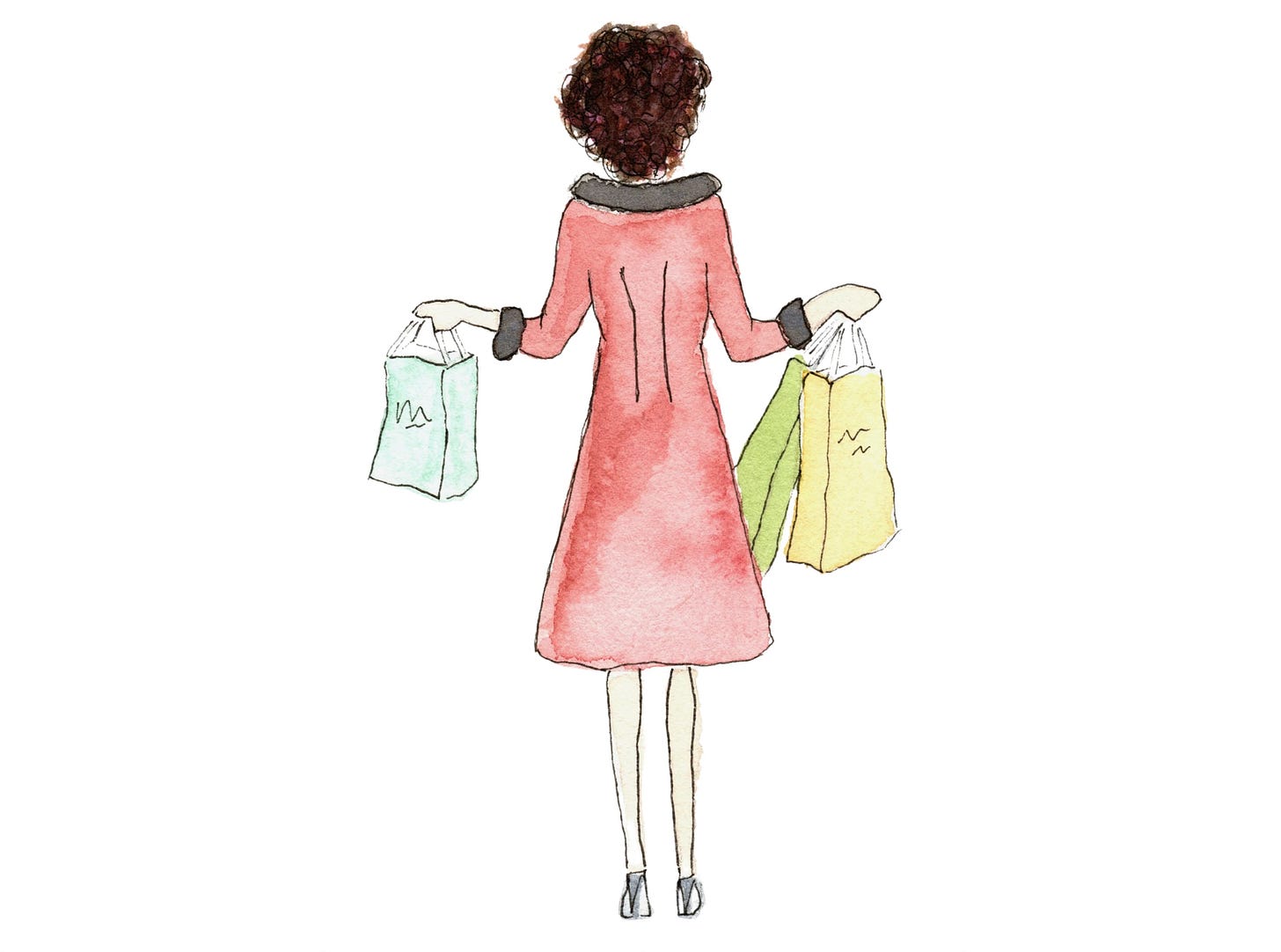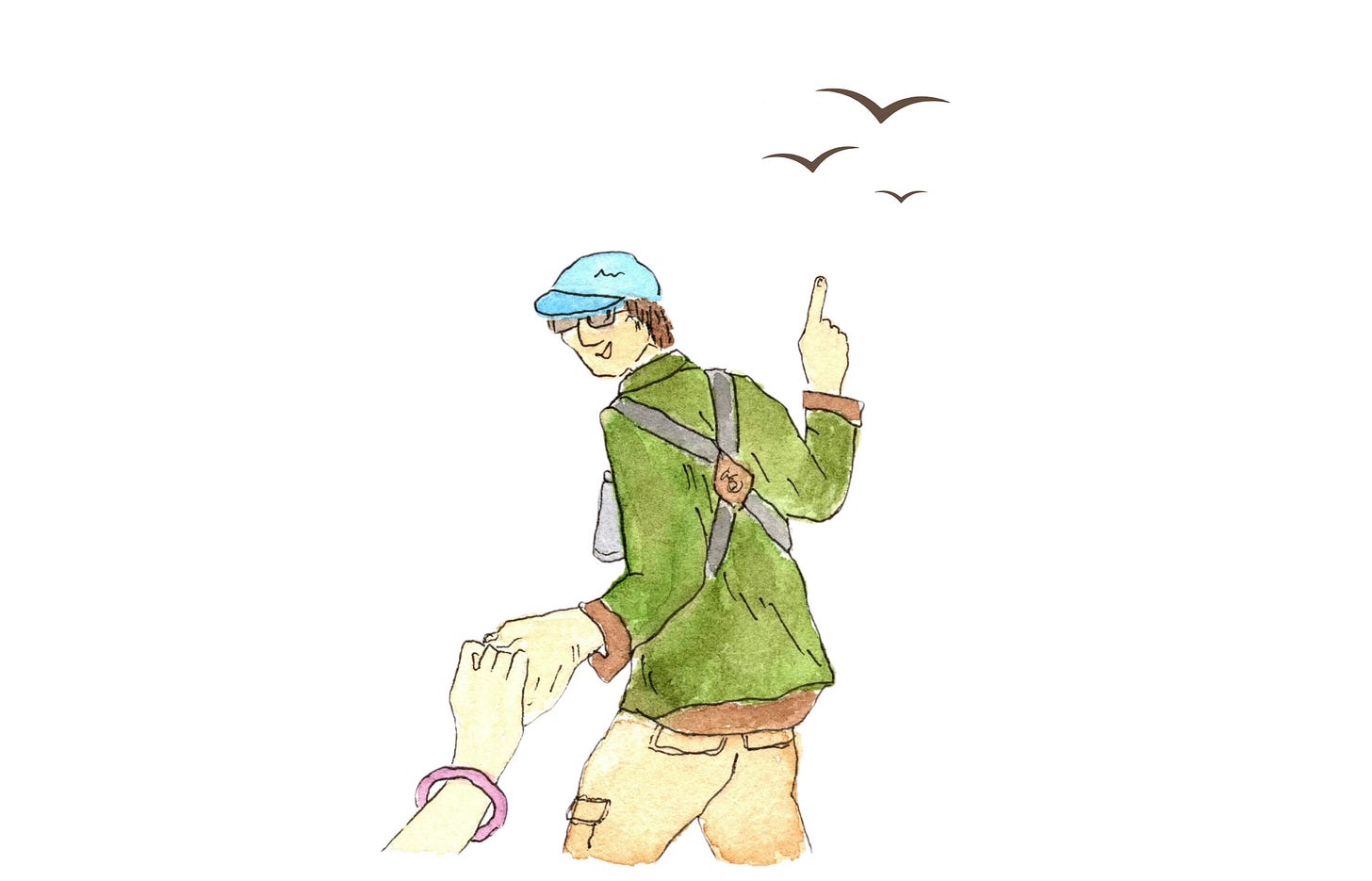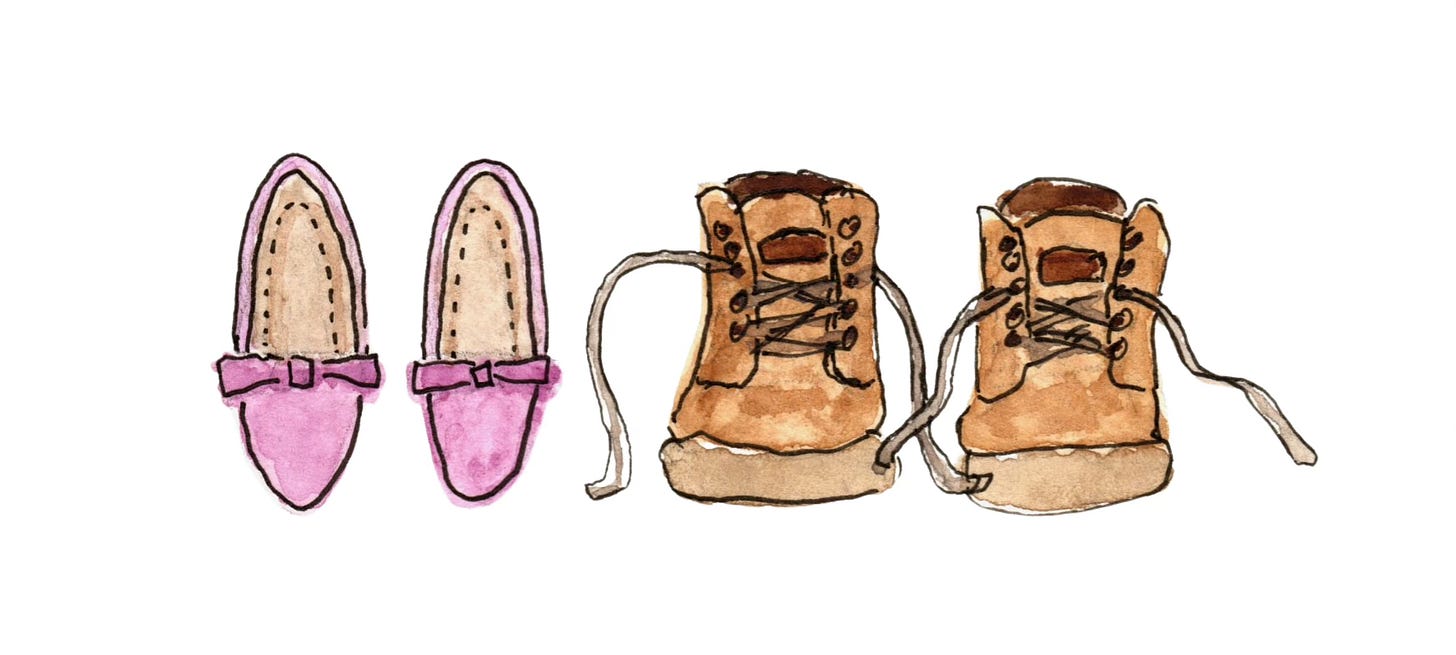Hi and welcome to The Accidental Birder where stories of travel, birds, and love intertwine in this illustrated memoir. Enjoy!
At 5:00 a.m., deep in the Ecuadorian Amazon, the unrelenting rain poured down, warm as bathwater. Plunk, plunk, plunk. Enormous drops that gleamed under the glow of my headlamp pelted my head, shoulders, arms, and back. Our small group of six moved in single file along a slippery boardwalk. Its aged wooden planks slick with moisture, suspended over a swamp teeming with anaconda, caiman, and piranha.
We were up early to walk the two-mile path my husband, Steve, and I had christened the “death march.” The previous four days it hadn’t rained, and each time we traversed the trail the air hung heavy with humidity, soaking our shirts and pants with sweat. It was as though the air was screaming for a thunderstorm.
The hike challenged us, not with technical terrain or treacherous paths, but with the sheer persistence it demanded. We’d trudge through dense towers of cecropia, mahogany, and kapok trees, surrounded by lush leaves, tall trunks, and tangled roots. But the trail offered no landmarks, like a fallen tree or a big rock, to serve as waypoints. With no sense of progress, the journey always stretched on. A neverending passage that defied time.
In the early-morning dark, the “death march” turned brutal, every step more punishing than the last and demanding my full attention. As rain lashed down, swarms of bugs, drawn to my headlamp, dive-bombed my face, leaving me disoriented. New hiking boots notwithstanding, my foot slipped—just barely—and panic surged at the thought of tumbling off the boardwalk into the stagnant black water below where predators lurked unseen.
This wasn’t the first birding trip Steve and I had embarked on, but it was by far the most punishing. I knew hikes in the tropics could be tricky, but this was on another level. The Amazon, with its endless humidity, treacherous labyrinth of trails, and ever-present dangers, turned every step into a test of endurance.
Exhausted and soaked, I muttered, “I’d rather be back at the office working on PowerPoint.”
No one on vacation says that. Ever.
I found myself here because, a few years earlier, I had met Steve just as I was nearing 40. He was a birder, though he took his time to reveal that. “It’s not the best way to attract girls right at the start,” he confessed later.
He wasn’t wrong. Back then, my hobbies revolved around girlfriend getaways to New York City, packed with shopping, museum-hopping, Broadway shows, and opera. Flipping through a field guide to identify birds didn’t exactly align with the polished, cosmopolitan life I’d crafted for myself since I’d left home at 18.
I didn’t grow up traveling. With my dad’s modest income and my mom busy raising five kids, our vacations were shoestring affairs, consisting of road trip adventures in a van without air conditioning. We’d pile in and head to national parks or drive for days to visit cousins in other states. Most often, we camped along the Oregon Coast, where we braved the frigid waters of the Pacific, wandered trails beneath towering Douglas Fir trees, and collected shells on rocky beaches.
Our family vacations were a blend of chaos and charm. The back seat was a battleground of sibling squabbles, punctuated by impatient cries of “Are we there yet?” Though, each time, the night before a trip felt magical. I’d lie awake, unable to sleep, as the excitement bubbled up inside me. It always felt like the kind of adventure that could reshape me. Sometimes, just the idea of being somewhere new was enough to spark potential transformation.
After university, in the late 1980s, I moved to the San Francisco Bay with a group of friends, all of us chasing dreams of landing jobs at the next big start-up. I pictured stock options, a livable salary, and just enough luck to make it work. But with a bachelor’s degree in hand and a recession gripping the economy, I ended up answering phones at the same company where most of my friends had found jobs, just so I could pay rent and establish myself in the workforce.
When two of my friends from work—a couple—and I had nowhere to go for Thanksgiving, a co-worker invited us to his parents’ house in tony Atherton. The home was a curated gallery of artifacts from their travels around the world: A mask in the shape of an antelope, a wood carving of a prehistoric naked man, swirled venetian glass, ancient tools displayed in a shadow box. Each piece was framed or perched on a pedestal. Prized trophies from a life well-traveled.
At dinner I was seated beside the only other single person in the room. “Where have you traveled?” he asked.
I froze, caught as an imposter in this crowd. In my mind, I’d been nowhere.
“Oh, you know. Lots of places,” I lied quickly, and then turned the question back on him. “How about you?”
My travels hadn’t gone beyond the U.S., and certainly not to places where you’d collect artifacts worthy of display. The closest thing I had was a road runner trinket I’d bought at thirteen. I purchased it with my babysitting money at a New Mexico souvenir shop during a family road trip to the Southwest. It looked like bronze, though I’m sure it was made from something much cheaper.
Answering phones wasn’t the path to progress I envisioned, so I set my sights on more meaningful, higher-paying work. A door soon opened that led to better opportunities, but it still wasn’t enough. After ten years of grinding away without ever seeing those elusive company shares, and with barely enough disposable income to dream of travel, I finally left California. A significant boost in my career led me to Utah, offering a chance at a better life—one I could afford.
Not long after, I bought a condo, got my passport, and seized a chance to spend a week in Rome with my mom when I came across an irresistible deal. It was a whirlwind trip, so quick I barely had time to process just how far I’d ventured. Wide-eyed and in awe, we wandered cobblestone streets, stepping into the living history we’d only known from books and photos.
Rome whetted my appetite to see more of the world, but life had other plans. My corporate job finally delivered a decent salary and stock options, but it also anchored me. My travel became practical, not adventurous. Mostly business trips.
I started racking up frequent flyer miles—from one division office to another. I saw more cubicles than I did landmarks. Occasionally, I’d steal an extra day after meetings to explore a new city, but true vacations became rare. When I did take time off, it wasn’t to jet to distant corners of the globe. It was to New York City or Chicago where I indulged in shopping and theatre.
My credit card statements became souvenir logs of these trips: a silk scarf from one boutique, a leather brand-name purse from another, and an embarrassing number of shoes from a store in New York City. There were even side trips to a Nordstrom in New Jersey because no sales tax on clothing felt like its own kind of adventure.
When I first met Steve, he couldn’t have cared less what scarf I wore or the brand name on my handbag. He spoke of lush tropical places where he dreamed of finding birds I never knew existed. He was from Canada, but had lived in Scotland, Russia, France, Switzerland, and Qatar. My life had been small and contained. His was expansive and full of possibility. He might show me the world, I thought.
I took his hand, letting him lead me to places I never imagined I’d see. As we traveled, I’d find the heart of a place through its feathered residents—exploring birding hotspots that breathed life into a country. It was a completely different way to experience a destination.
After the grueling two-mile hike, I felt a wave of relief at the sight of our motorized canoe and driver waiting on the Napo River. As the sun rose, colors gradually emerged, revealing the vibrant greens of the landscape and the soft gray-blue water of the river. A mist lingered over the water and treetops like a delicate veil. The rain had finally stopped, and the forest awakened with a chorus of birdsong.
Steve and I climbed into the canoe, holding tight to each other as it bounced and rocked along the river. For 30 minutes we sped forward, the driver navigating swiftly toward a salt lick carved into the cliffs along the riverbank.
We were on our way to see throngs of Blue-headed Parrots, Mealy Amazon Parrots, and Dusky-headed Parakeets.
When we arrived, the air erupted with high-pitched chatter and squawking. Greens and blues blurred together as birds flapped their wings and clung to the clay-rich cliffs. Drawn to the vital minerals essential for neutralizing toxins in their plant-based diets, these winged visitors rely on the clay as a lifeline. Survival in the Amazon is a constant battle, with plants arming themselves with defensive chemicals. For these birds, the minerals in the clay are indispensable to their existence..
I raised my binoculars, drawn into the mesmerizing spectacle before me. Parrots and parakeets jostled and crowded others out, while some waited patiently on nearby branches, biding their time. It was a morning feast, a vital ritual for survival in this untamed place.
I had never seen feathers like these. The vivid, iridescent blue of the Blue-headed Parrot shimmering in the light and the powdery green of the Mealy Amazon Parrot with its delicate hints of blue and purple on its crown. The small but lively Dusky-headed Parakeet with its soft green blended seamlessly with the branches until it ventured onto the clay cliffs, revealing its subtle, dusky head.
Goosebumps rippled over my arms as I took it all in. The kaleidoscope of color and the trills, squawks, and chatter. For once, I wasn’t thinking of PowerPoint presentations or the weight of to-do lists. I was fully present, immersed in a scene both wild and breathtakingly alive.
There were no souvenirs to bring back, no trinkets to place on a shelf. The things that showed up on a credit card statement had never held me the way this moment did.
That scarf I bought so many years ago? I don’t even remember what it looked like. That purse? I think I gave it away to a friend. The only pair of shoes that survived my shopping sprees are the merlot-suede Jimmy Choos I wore on my wedding day. They sit on the same shelf next to my hiking boots.














Lisa, Beautiful writing. Love your watercolors, too. You make me want to tromp through the Ecuadorian jungle and float down the Napo River to see the eruption of parrots and parakeets. I'm getting back to writing in earnest, like this bit about Baja California: https://oneboyswayofknowing.com/2025/03/01/the-broken-down-bus/
Lisa, I loved reading your story and your illustrations are fabulous. Everything about this makes me smile. Congratulations on taking flight.